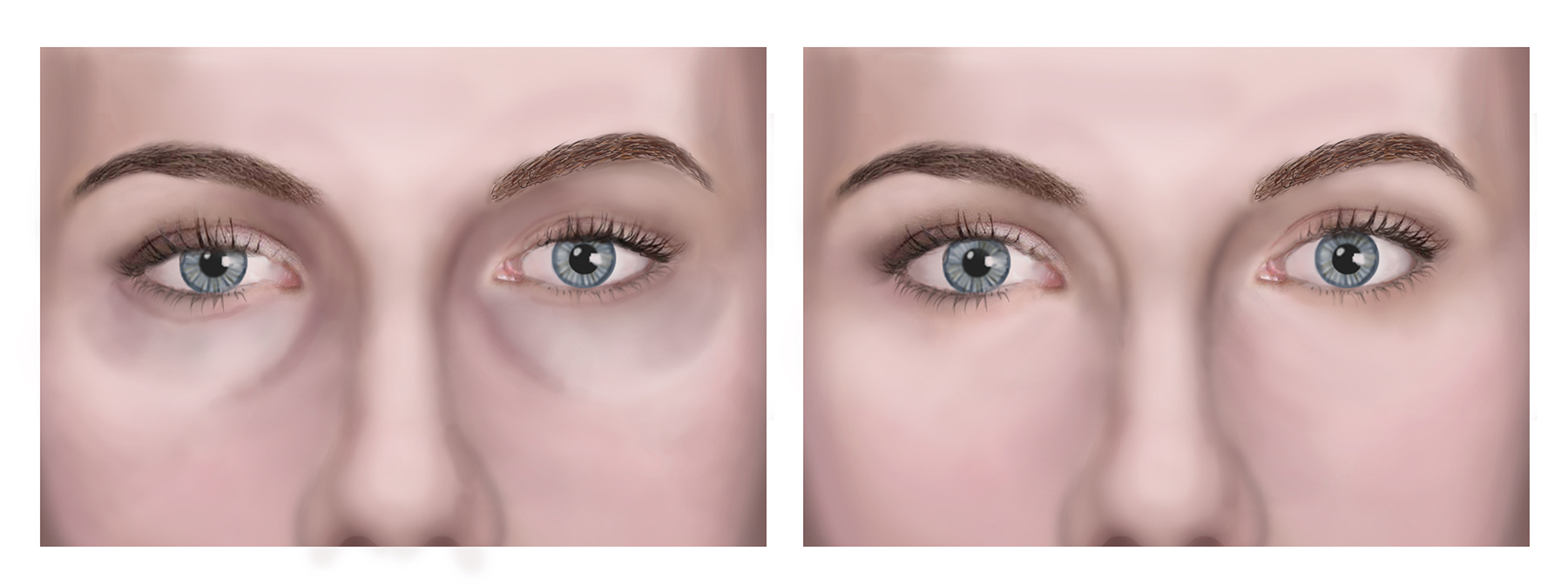Filling the tear trough and hollows around the eyes is the single most transformative non-surgical breakthrough technique—and it is the signature non-invasive specialty of my practice.

Almost without exception everyone has a tear trough. But where exactly is it? It is the slight depression under the eye where a tear would normally flow. While the tear trough is not necessarily a byproduct of age, it does tend to grow deeper and more pronounced as time goes on. Eventually these hollows not only contribute to tired looking eyes but accentuate dark circles and fat bags which tend to grow larger and looser with age. Surgery cannot fully correct this problem—but fillers can. However, not everyone is a candidate to have fillers done without prior surgery. If bulging fat and loose skin are present, lower lid surgery may be needed in tandem with the tear trough filling or the overall appearance can actually look worse.
The procedure to inject the tear trough and the hollows around the eyes is essentially painless because multiple levels of numbing are used. The results last between 1-3 years with often only touch up procedures enough to maintain results. Very rarely a second layer is necessary for those with particularly deep troughs. For those who need surgical correction, the tear trough procedure is recommended 3 months post operatively.
The choice of filler is discussed at consultation. The hyaluronic acid type fillers are particularly suitable due to their softness and reversibility.
Both men and women benefit from this procedure. Because no scarring is involved, men feel particularly comfortable with this enhancement.
Priorities
The first and most important priority is to be certain you are a good candidate for this procedure, which is accomplished during a consultation. The second priority is to understand what areas need treatment beyond the tear trough. It is important that all adjacent areas—the total eye, cheeks, and midface are all corrected simultaneously if indicated, to avoid disharmony, especially as it relates to facial movements.
The precise prescription is critical. The options are filling the tear trough only, filling the tear trough and adjacent areas only, or a combination of surgery and filling, if fat bags and loose skin are present.
The third priority is your responsibility. You must consider only expert, experienced injectors that specialize in injections around the eyes. Non-invasive treatments are usually approached more casually because to the average person, “surgery” is inherently more serious and risky. This is not necessarily the case, especially when it comes to the eye area. In fact, the tear trough procedure is the one with the largest number of outside referrals requesting a correction. What can go wrong?
- Excessive crepiness under the eyes with abnormal bulges and irregularities
- Accentuated appearance of bags under the eye
- Overall eye aesthetics worsening
- Prolonged swelling
- Distorted or disharmonious facial expression
Hirmand Tear Trough and MicroBeading Techniques
Tear Trough Procedure:
This injection procedure is the signature specialty non-surgical procedure of my practice. It has been a subject of personal research interest since early 2000’s which has resulted in many presentations, and publication of journal articles and book chapters over the years.
My preferred approach is a technique I developed in 2003 using custom-made blunt needles for safety and precision of injection. These blunt needles, custom-designed for this procedure, are now popularized for general use.
These blunt needles allow very minute amounts of filler to be placed deep into the hollows through microscopic access holes in the skin. The filler is molded into place in such a way to create a smooth contour without any irregularities. The result is a subtle filling and smoothening of the inner circles, leaving no trace of the procedure.
A precise and customized plan is developed for every person. All areas that are contiguous with the tear trough are treated at the same time including the full circumference of lower lid hollows, the midface, cheeks and under the malar bags. At times, the upper lid sulcus and temples may also need to be treated to keep harmonious proportions. Photographs are taken for future reference. Experience, meticulousness and aesthetic vision are key components for success.
Newer filler options are now available that minimize the risk of the blue hue under thin skin and minimize the swelling.
MicroBeading of the EyeLids:
A note on Microbeading of the lower lid…
The lower eyelid (and upper eyelid) age in tandem with the tear trough by losing volume but thus far adding volume to the eyelids has been challenging. Regular maintenance injections in the tear troughs, cheeks and midface often exacerbate the hollowed appearance of the eyelids. The final frontier for correction of volume loss is the lower and upper lids. The MicroBeading procedure developed for the lower lid is not only new, but a more advanced and intricate extension of the tear trough procedure.
Technique: Smaller caliber blunt micro-needles are used to introduce miniscule droplets of filler homogenously in a fanning pattern, under the skin and muscle, to lift the “hollowed out” eyelids and bring them back to life. Adding volume to the lower eyelid above the tear trough and often into the upper eyelid is intricate and requires precise execution. A fraction of a millimeter makes a significant aesthetic change in the eyes and face.
This novel technique is not mainstream, but offers a powerful tool to treat the “sunken eye look” and contradict excessive hollowness of from aging and thinning of the tissues, the deep set appearance exacerbated by maintenance of the cheeks and tear troughs, and even hollowness after eye surgery caused by aggressive reduction of fat.
The MicroBeading technique can also be used for volume correction in the upper lid and brow in the right candidate.
Surgical notes
Anesthesia: local and topical
Length of procedure: 30-60 minutes depending on complexity
Outpatient/inpatient: outpatient
Adjunct procedures: filling of other facial areas, Blepharoplasty
Recovery: none, there may be bruising requiring concealer